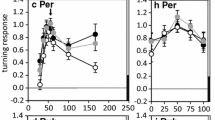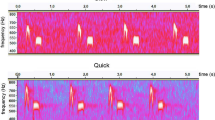Summary
Sexually responsive female crickets (Acheta domesticus) were exposed to electronically synthesized model calling songs (CSs) in an orientation arena. The female's walking during exposure to the CSs was recorded on videotape, digitized, and then analyzed using an algorithm that calculated the distance the female walked in 10 ° angle intervals (angle±5 °) with respect to the location of the sound source. The resulting polar orientation diagram (POD) presented the directional movements of 10 or more females with respect to the CS source. The PODs show that females responded to very attractive model CSs by walking directly toward the speaker. Less attractive CSs produced progressively less or no orientation toward the CS source.
Each of the CS parameters was systematically changed and its attractiveness was evaluated:
-
1.
Syllable period: A 50 ms syllable period CS (modal for the natural call at 22 °C) was more attractive than CSs with syllable periods of 60 or 70 ms that also are within the natural range (Fig. 2). Syllable periods (30, 40 and 80 ms) were progressively less attractive as they deviated further from the natural range.
-
2.
Syllable duration: For CSs with a 50 ms syllable period, a 25 ms syllable duration (modal for natural calls) was most attractive (Fig. 3). Other syllable durations (10, 15, 20, 30, 35, 40 ms) were progressively less attractive as they deviated further from 25 ms. With an 80 ms syllable period, CS syllable durations of 40 and 55 ms were most attractive to females (Fig. 4). Other syllable durations were less attractive (25 ms) or very unattractive (10 and 70 ms). These results suggest that the length of the quiet period between syllables or a duty cycle relationship could be important features of the calling song.
-
3.
Number of syllables: Model CSs with three syllables (the modal value for the natural call) were responded to most directly (Fig. 5). CSs with 2 or 4 syllables (produced less frequently in the natural call) were less attractive and CSs with 1 and 5 syllables were still less attractive.
-
4.
Chirp rates: Model CSs with chirp rates of 1.5 and 2/s (most typical of stably calling males) were most attractive (Fig. 6). Chirp rates that were slower (0.5 and 1/s) and faster (4/s) were less attractive.
-
5.
Frequency and intensity: Model CSs with carrier frequencies of 4–5 KHz were responded to positively over a range of 45 to 86 dB (Fig. 7). Positive phonotaxis was also seen at 3 kHz, 85 dB. All other frequencies (2, 7, 9 and 13 kHz) resulted in either negative phonotaxis or little directional orientation. Thus positive phonotaxis is sharply tuned to the 4–-5 kHz band of carrier frequencies. Model CSs produced at 4 kHz with intensities ranging from 55 to 85 dB were equally attractive (Fig. 8). CSs produced at 13 kHz were responded to negatively at 55 dB and somewhat positively at 95 dB (Fig. 9). A mixture of 13 kHz and 4 kHz resulted in a negative response by many of the females to the model CS (Fig. 10). Thus for some females high carrier frequencies (13 kHz) inhibit the usual positive phonotaxis to a 4 kHz chirp.
From these results, it is apparent that a change in any of the spectral or temporal parameters of the calling song altered its attractiveness to sexually responsive females. Thus, each feature of the calling song is encoded and used by the female cricket's nervous system in determining the attractiveness of a calling male. However, some CS features are more important than others.
Similar content being viewed by others
Abbreviations
- CS :
-
model calling song
- POD :
-
polar orientation diagram
References
Elsner N, Popov A (1978) Neuroethology of acoustic communication. Adv Insect Physiol 13:229–335
Esch H, Huber F, Wohlers D (1980) Primary auditory neurons in crickets: physiology and central projections. J Comp Physiol 137:27–38
Helversen D von (1972) Gesang des Männchens und Lautschema des Weibchens bei der FeldheuschreckeChorthippus biguttulus (Orthoptera, Acrididae). J Comp Physiol 81:381–422
Hill K (1974) Carrier frequency as a factor in phonotactic behavior of female cricketsTeleogryllus commodus. J Comp Physiol 93:7–18
Hill K (1975) Acoustic communication in the Australian field cricketsTeleogryllus commodus andT. oceanicus (Orthoptera: Gryllidae). Doct. thesis, University of Melbourne
Hill K, Boyan G (1977) Sensitivity to frequency and direction of sound in the auditory system of crickets (Gryllidae). J Comp Physiol 121:79–97
Moiseff A, Polack G, Hoy R (1978) Steering responses of flying crickets to sound and ultrasound: mate attraction and predator avoidance. Proc Natl Acad Sci 75:4052–4056
Murphy R, Zaretsky M (1972) Orientation to calling song by female crickets,Scapsipedus marginatus (Gryllidae). J Exp Biol 56:335–352
Popov A, Shuvalov V (1977) Phonotactic behavior of crickets. J Comp Physiol 119:111–116
Popov A, Shuvalov V, Svetlogorskaya I, Markovich A (1974) Acoustic behavior and auditory system in insects. In: Schwarzkopff J (ed) Mechanoreception. Rheinisch Westfael Akad Wiss Abh 53:281–306
Regen I (1913) äber die Anlockung des Weibchens vonGryllus campestris L. durch telephonisch übertragene Stridulationslaute des Männchens. Pflügers Arch 155:193–200
Rheinlaender J, Kalmring K, Popov A, Rehbein H (1976) Brain projections and information processing of biologically significant sounds by two ventral-cord neurons ofGryllus bimaculatus deGeer (Orthoptera, Gryllidae). J Comp Physiol 110:251–260
Schmitz B, Scharstein H, Wendler G (1982) Phonotaxis inGryllus campestris L. (Orthoptera, Gryllidae). I. Mechanism of acoustic orientation in intact female crickets. J Comp Physiol 148:431–444
Shuvalov V, Popov A (1973a) Significance of some of the parameters of the calling songs of male cricketsGryllus bimaculatus for phonotaxis of females. J Evol Biokh Fiziol 9:117–182
Shuvalov V, Popov A (1973b) The importance of the calling song rhythmic pattern of the males of the genusGryllus for phonotaxis of females. Zool J 52:1179–1185
Shuvalov V, Popov A (1979) On spectral selectivity and conditions of stimulation in phonotactic behavior of crickets (Gryllus bimaculatus De Geer). Dokl Akad Nauk USSR 246:247–249
Stout J, Huber F (1981) Responses to features of the calling song by ascending auditory interneurons inGryllus campestris L. (Gryllidae). Physiol Entomol 6:199–212
Stout J, Gerard G, Hasso S (1976) Sexual responsiveness mediated by the corpora allata and its relationship to phonotaxis in the female cricket,Acheta domesticus L. J Comp Physiol 108:1–9
Thorson J, Weber T, Huber F (1982) Auditory behavior of the cricket. II. Simplicity of calling song recognition inGryllus, and anomalous phonotaxis at abnormal carrier frequencies. J Comp Physiol 146:361–378
Walker R (1957) Specificity in the response of female tree crickets (Orthoptera: Gryllidae: Oecanthinae) to calling songs of males. Ann Entomol Soc Am 50:626–636
Weber T, Thorson J, Huber F (1981) Auditory behavior of the cricket. I. Dynamics of compensated walking and discrimination paradigms on the Kramer treadmill. J Comp Physiol 141:215–232
Wendler G, Dambach M, Schmitz B, Scharstein H (1980) Analysis of the acoustic orientation behavior in crickets (Grylluscampestris L.) Naturwissenschaften 67:99–101
Zaretsky M (1972) Specificity of the calling song and short term changes in phonotactic response by female crickets,Scapsipedus marginatus (Gryllidae). J Comp Physiol 79:153–172
Author information
Authors and Affiliations
Rights and permissions
About this article
Cite this article
Stout, J.F., DeHaan, C.H. & McGhee, R.W. Attractiveness of the maleAcheta domesticus calling song to females. J. Comp. Physiol. 153, 509–521 (1983). https://doi.org/10.1007/BF00612605
Accepted:
Issue Date:
DOI: https://doi.org/10.1007/BF00612605




